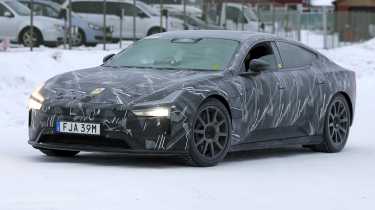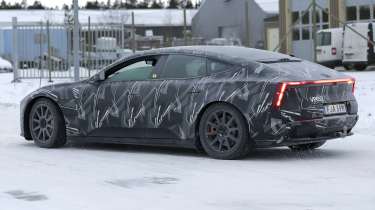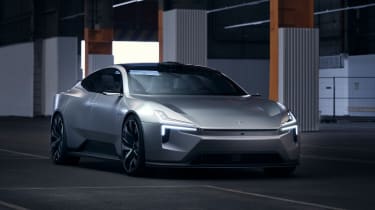Polestar 5 gunning for Porsche Taycan as 871bhp flagship
Still think Polestar’s just a Volvo offshoot? The 871bhp Polestar 5 will probably change that. Here's our first glimpse
The Polestar 5 is set to be the marque's answer to high-end EVs like the Porsche Taycan, Audi e-Tron GT and Tesla Model S, and over four years since it was first previewed with the Precept concept, test mules have now been spotted out on the road. An exact on sale date is yet to be confirmed, but expect to be see the model in full in 2025 before order books open.
The target for the 5 is a 871bhp peak power output and 664lb ft peak torque figure, derived from two electric motors that run on an 800V electrical system. This makes the new Polestar 5 all-wheel drive, however the large single rear motor suggests that power torque-vectoring on the rear axle (as is found on the Model S Plaid) might not be integrated.
> Polestar 4 2024 review – 536bhp crossover is the fastest yet
The sleek four-door saloon is built on Polestar’s own bespoke architecture, a brand new bonded aluminium structure being developed here in the UK with expertise derived from brands such as McLaren, Aston Martin and Lotus – not to mention a few of the F1 teams dotted around the countryside. Polestar’s British R&D team started out small, with just 81 staff in 2018, but has grown quickly with the expansion of its UK facility.
The reason behind Polestar’s decision to set up a satellite engineering hub outside of its Gothenburg and Chengdu HQ and manufacturing centres was for a very simple and enticing reason. Polestar wants the Polestar 5 to not just rival the Taycan in terms of range or comfort, but also driving dynamics, something it’s investing in properly with this new ground-up architecture and the staff who know how to deliver it.
The bonded aluminium chassis itself will give engineers the chance to streamline its structure to reduce weight, and deliver specific proportions unique from any Volvo model. The construction method itself isn’t dissimilar to the system employed by Aston Martin, and should also yield excellent torsional rigidity. To this structure, Polestar will fit a low-line battery pack with a scoop taken out of the rear passenger section – as is found in the Porsche Taycan – but Polestar will allow for more rear legroom than the Porsche, something that will be mirrored in the 5’s ultimate chassis tune with a more relaxed GT-like setup being initially prioritised.
The Polestar 5 design will be directly derived from the 2020 Precept Concept, and as these latest spy shots confirm, the production car receives only subtle changes to the detailing, panel junctions and lighting. The proportions are the first thing that look accurate, with a long bonnet, wheelbase and sloping roofline. This style of long coupe-cum-hatchback is not unusual for modern electric cars – the Tesla Model S introduced the look as far back as 2009 – but for one key element that’s visible in these images: a complete lack of a rear screen, just like the Polestar 4.
Other elements have also been directly brought over from the Precept, including the compact split headlights which are driven by a new interpretation of the Thor’s Hammer headlight graphic, while the grille has been replaced entirely, now forming both a home for the concept’s safety sensors and driving assistance functions. There’s also a small slip vent integrated into that same space which attaches air to its body, forcing it up and over the windscreen – a similar trick to that found on the Jaguar I-Pace.
We'll have to wait a bit longer still to see Polestar’s full potential in the 5, but by all accounts so far it doesn’t look like we’re about to be disappointed.






